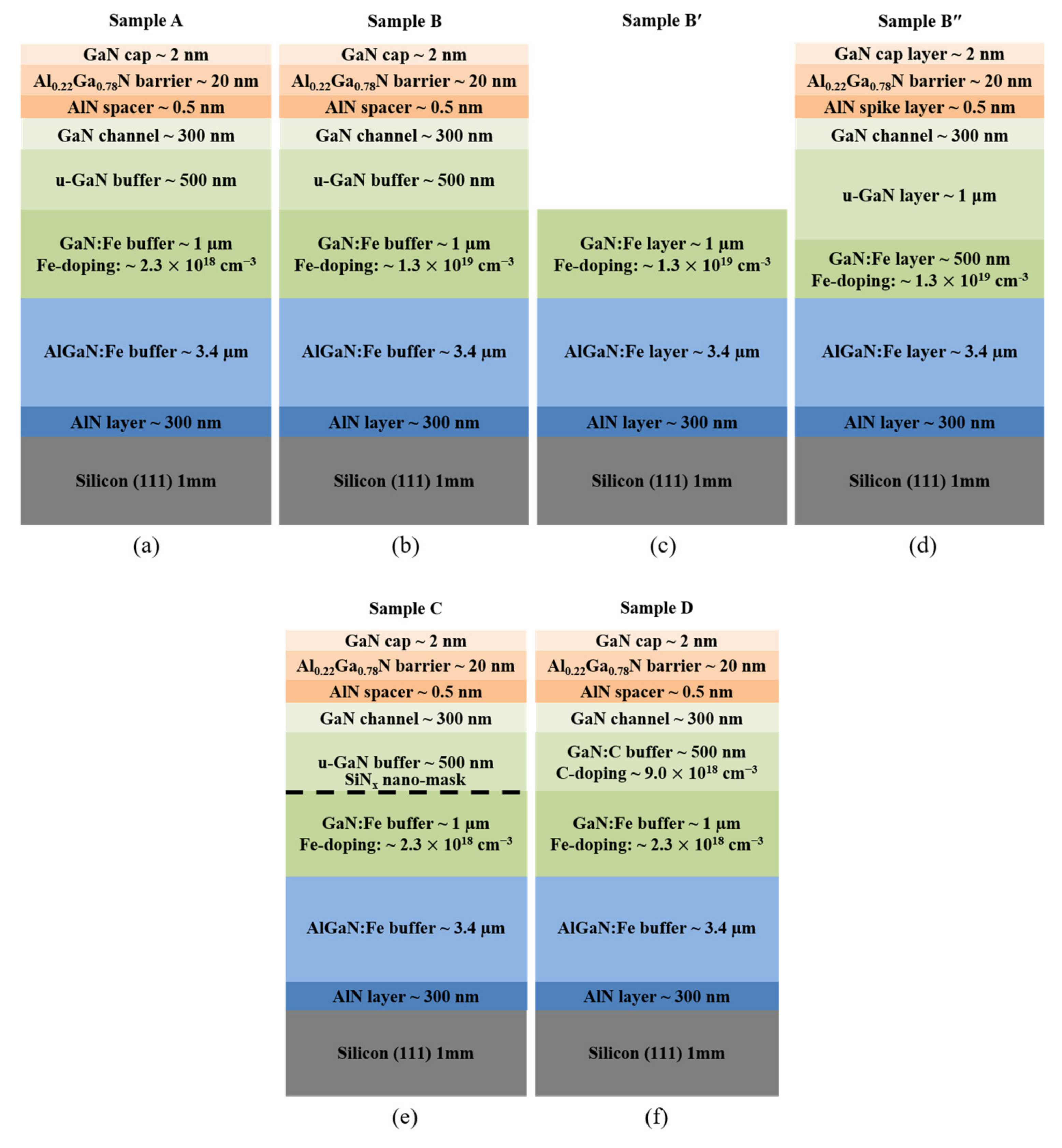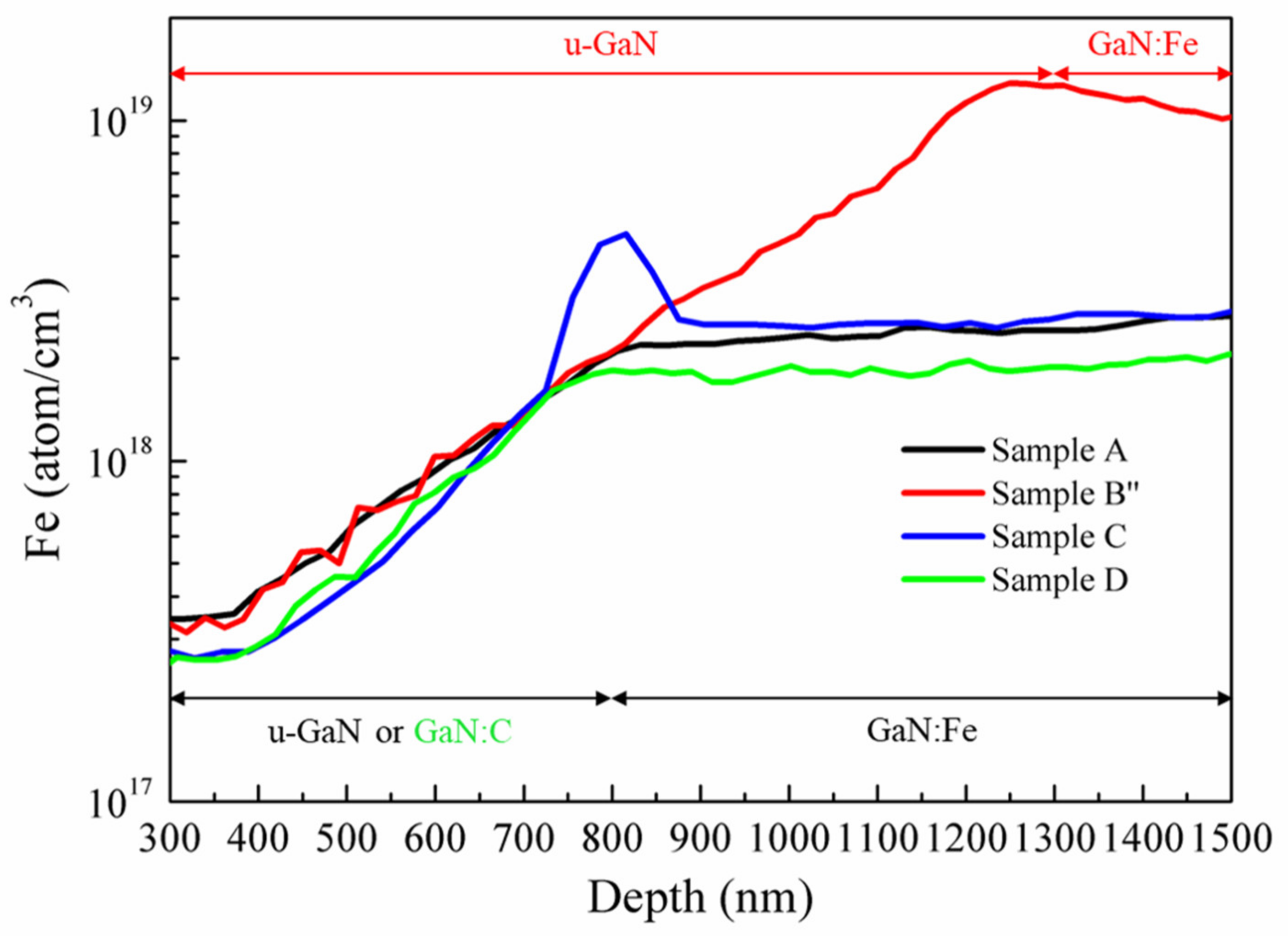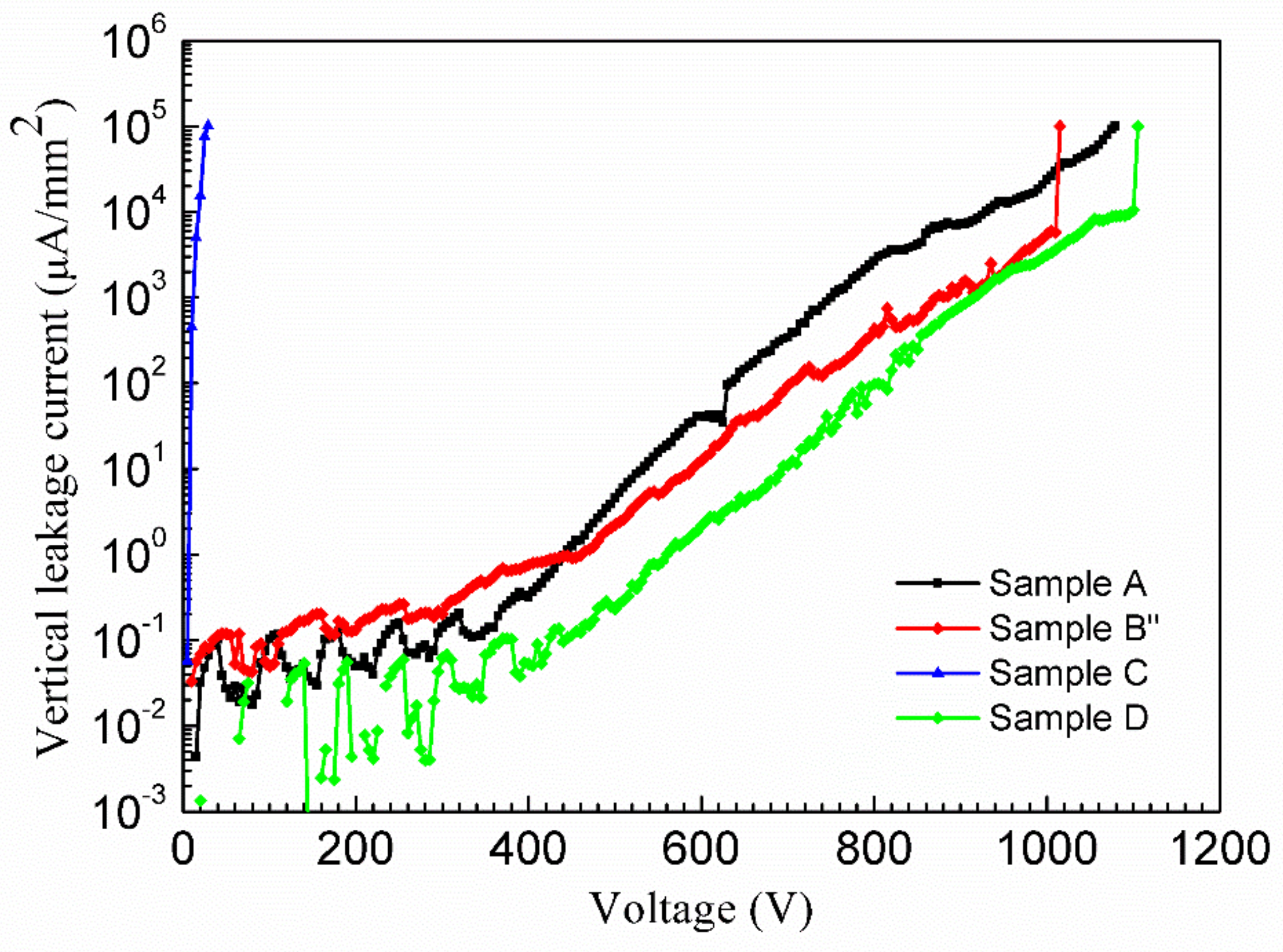The Effect of Heavy Fe-Doping on 3D Growth Mode and Fe Diffusion in GaN for High Power HEMT Application
Abstract
:1. Introduction
2. Materials and Methods
3. Results and Discussion
4. Conclusions
Author Contributions
Funding
Institutional Review Board Statement
Informed Consent Statement
Data Availability Statement
Acknowledgments
Conflicts of Interest
References
- Amano, H.; Baines, Y.; Beam, E.; Borga, M.; Bouchet, T.; Chalker, P.R.; Charles, M.; Chen, K.J.; Chowdhury, N.; Chu, R.; et al. The 2018 GaN power electronics roadmap. J. Phys. D Appl. Phys. 2018, 51, 163001. [Google Scholar] [CrossRef]
- Chen, K.J.; Haberlen, O.; Lidow, A.; Tsai, C.L.; Ueda, T.; Uemoto, Y.; Wu, Y. GaN-on-Si Power Technology: Devices and Applications. IEEE Trans. Electron Devices 2017, 64, 779–795. [Google Scholar] [CrossRef]
- Yang, S.; Han, S.; Sheng, K.; Chen, K.J. Dynamic On-Resistance in GaN Power Devices: Mechanisms, Characterizations, and Modeling. IEEE J. Emerg. Sel. Top. Power Electron. 2019, 7, 1425–1439. [Google Scholar] [CrossRef]
- Marchand, H.; Zhao, L.; Zhang, N.; Moran, B.; Coffie, R.; Mishra, U.; Speck, J.; DenBaars, S.; Freitas, J. Metalorganic chemical vapor deposition of GaN on Si (111): Stress control and application to field-effect transistors. J. Appl. Phys. 2001, 89, 7846–7851. [Google Scholar] [CrossRef]
- Tanaka, S.; Honda, Y.; Sawaki, N.; Hibino, M. Structural characterization of GaN laterally overgrown on a (111)Si substrate. Appl. Phys. Lett. 2001, 79, 955–957. [Google Scholar] [CrossRef]
- Dai, J.-J.; Liu, C.-W.; Wu, S.-K.; Huynh, S.-H.; Jiang, J.-G.; Yen, S.-A.; Mai, T.T.; Wen, H.-C.; Chou, W.-C.; Hu, C.-W.; et al. Improving Transport Properties of GaN-Based HEMT on Si (111) by Controlling SiH4 Flow Rate of the SiNx Nano-Mask. Coatings 2020, 11, 16. [Google Scholar] [CrossRef]
- Wang, T.Y.; Ou, S.L.; Horng, R.H.; Wuu, D.S. Growth evolution of Si x N y on the GaN underlayer and its effects on GaN-on-Si (111) heteroepitaxial quality. CrystEngComm 2014, 16, 5724–5731. [Google Scholar] [CrossRef] [Green Version]
- Li, Y.; Chen, S.; Kong, M.; Li, S.; Tian, W.; Sun, S.; Wu, Z.; Fang, Y.; Dai, J.; Chen, C. Defect reduction in Si-doped Al0.45Ga0.55N films by SiNx interlayer method. J. Appl. Phys. 2014, 115, 043503. [Google Scholar] [CrossRef]
- Chang, S.; Lung Wei, L.; Tung Luong, T.; Chang, C.; Chang, L. Threading dislocation reduction in three-dimensionally grown GaN islands on Si (111) substrate with AlN/AlGaN buffer layers. J. Appl. Phys. 2017, 122, 105306. [Google Scholar] [CrossRef]
- Chang, K.-P.; Lin, P.-J.; Horng, R.-H.; Wuu, D.-S. Growth characteristics of Fe-doped GaN epilayers on SiC (001) substrates and their effects on high breakdown voltage devices. Mater. Sci. Semicond. Process. 2020, 119, 105228. [Google Scholar] [CrossRef]
- Yacoub, H.; Zweipfennig, T.; Lukens, G.; Behmenburg, H.; Fahle, D.; Eickelkamp, M.; Heuken, M.; Kalisch, H.; Vescan, A. Effect of Carbon Doping Level on Static and Dynamic Properties of AlGaN/GaN Heterostructures Grown on Silicon. IEEE Trans. Electron. Devices 2018, 65, 3192–3198. [Google Scholar] [CrossRef]
- Tokuda, H.; Suzuki, K.; Asubar, J.T.; Kuzuhara, M. Electron concentration in highly resistive GaN substrates co-doped with Si, C, and Fe. Jpn. J. Appl. Phys. 2018, 57, 71001. [Google Scholar] [CrossRef]
- Chiu, H.-C.; Chen, S.-C.; Chiu, J.-W.; Li, B.-H.; Xuan, R.; Hu, C.-W.; Hsueh, K.-P. Effect of various Fe-doped AlGaN buffer layer of AlGaN/GaN HEMTs on Si substrate. J. Vac. Sci. Technol. B Nanotechnol. Microelectron. Mater. Process. Meas. Phenom. 2017, 35, 41205. [Google Scholar] [CrossRef]
- Yacoub, H.; Mauder, C.; Leone, S.; Eickelkamp, M.; Fahle, D.; Heuken, M.; Kalisch, H.; Vescan, A. Effect of Different Carbon Doping Techniques on the Dynamic Properties of GaN-on-Si Buffers. IEEE Trans. Electron Devices 2017, 64, 991–997. [Google Scholar] [CrossRef]
- Joshi, V.; Tiwari, S.P.; Shrivastava, M. Part I: Physical Insight Into Carbon-Doping-Induced Delayed Avalanche Action in GaN Buffer in AlGaN/GaN HEMTs. IEEE Trans. Electron Devices 2019, 66, 561–569. [Google Scholar] [CrossRef]
- Nakano, Y. Electrical Investigation of Turn-On Capacitance Recovery Characteristics in Carbon-Doped AlGaN/GaN Hetero-Structures Grown on Si Substrates. ECS J. Solid State Sci. Technol. 2017, 6, P828–P831. [Google Scholar] [CrossRef]
- Tzou, A.-J.; Hsieh, D.-H.; Chen, S.-H.; Liao, Y.-K.; Li, Z.-Y.; Chang, C.-Y.; Kuo, H.-C. An Investigation of Carbon-Doping-Induced Current Collapse in GaN-on-Si High Electron Mobility Transistors. Electronics 2016, 5, 28. [Google Scholar] [CrossRef] [Green Version]
- Bergsten, J.; Thorsell, M.; Adolph, D.; Chen, J.-T.; Kordina, O.; Sveinbjornsson, E.O.; Rorsman, N. Electron Trapping in Extended Defects in Microwave AlGaN/GaN HEMTs With Carbon-Doped Buffers. IEEE Trans. Electron Devices 2018, 65, 2446–2453. [Google Scholar] [CrossRef]
- Uren, M.J.; Moreke, J.; Kuball, M. Buffer Design to Minimize Current Collapse in GaN/AlGaN HFETs. IEEE Trans. Electron Devices 2012, 59, 3327–3333. [Google Scholar] [CrossRef] [Green Version]
- Killat, N.; Uren, M.J.; Wallis, D.J.; Martin, T.; Kuball, M. Origin of kink effect in AlGaN/GaN high electron mobility transistors: Yellow luminescence and Fe doping. Appl. Phys. Lett. 2012, 101, 153505. [Google Scholar] [CrossRef]
- Heikman, S.; Keller, S.; DenBaars, S.P.; Mishra, U.K. Growth of Fe doped semi-insulating GaN by metalorganic chemical vapor deposition. Appl. Phys. Lett. 2002, 81, 439–441. [Google Scholar] [CrossRef]
- Polyakov, A.Y.; Smirnov, N.B.; Govorkov, A.V.; Pearton, S.J. Electrical and optical properties of Fe-doped semi-insulating GaN templates. Appl. Phys. Lett. 2003, 83, 3314–3316. [Google Scholar] [CrossRef]
- Sugimoto, K.; Nishihira, T.; Arita, N.; Dempo, Y.; Okada, N.; Tadatomo, K. Characterization of high electron mobility transistor fabricated on hydride vapor phase epitaxy-grown GaN templates containing various Fe concentrations. Phys. Status Solidi C 2017, 14, 1600246. [Google Scholar]
- Feng, Z.H.; Liu, B.; Yuan, F.P.; Yin, J.Y.; Liang, D.; Li, X.B.; Feng, Z.; Yang, K.W.; Cai, S.J. Influence of Fe-doping on GaN grown on sapphire substrates by MOCVD. J. Cryst. Growth 2007, 309, 8–11. [Google Scholar] [CrossRef]
- Arteev, D.; Sakharov, A.; Lundin, W.; Zavarin, E.; Zakheim, D.; Tsatsulnikov, A.; Gindina, M.; Brunkov, P. Influence of doping profile of GaN: Fe buffer layer on the properties of AlGaN/AlN/GaN heterostructures for high-electron mobility transistors. J. Phys. Conf. Ser. 2020, 1697, 012206. [Google Scholar] [CrossRef]
- Ishiguro, T.; Yamada, A.; Kotani, J.; Nakamura, N.; Kikkawa, T.; Watanabe, K.; Imanishi, K. New Model of Fe Diffusion in Highly Resistive Fe-Doped Buffer Layer for GaN High-Electron-Mobility Transistor. Jpn. J. Appl. Phys. 2013, 52, 8JB17. [Google Scholar] [CrossRef]
- Leone, S.; Benkhelifa, F.; Kirste, L.; Manz, C.; Mueller, S.; Quay, R.; Stadelmann, T. Suppression of Iron Memory Effect in GaN Epitaxial Layers. Phys. Status Solidi (B) 2018, 255, 1700377. [Google Scholar] [CrossRef]
- Era, A.; Hatakenaka, S.; Okazaki, H.; Kamo, Y.; Nishida, T.; Watanabe, H. Growth of crack-free GaN on Si HEMTs with Fe-doped GaN using un-doped GaN interlayer. In Materials Science Forum; Trans Tech Publications Ltd.: Bäch, Switzerland, 2016; pp. 1194–1197. [Google Scholar]
- Liu, J.Q.; Wang, J.F.; Liu, Y.F.; Huang, K.; Hu, X.J.; Zhang, Y.M.; Xu, Y.; Xu, K.; Yang, H. High-resolution X-ray diffraction analysis on HVPE-grown thick GaN layers. J. Cryst. Growth 2009, 311, 3080–3084. [Google Scholar] [CrossRef]
- Lin, P.-J.; Tien, C.-H.; Wang, T.-Y.; Chen, C.-L.; Ou, S.-L.; Chung, B.-C.; Wuu, D.-S. On the Role of AlN Insertion Layer in Stress Control of GaN on 150-mm Si (111) Substrate. Crystals 2017, 7, 134. [Google Scholar] [CrossRef] [Green Version]
- Kaganer, V.M.; Brandt, O.; Trampert, A.; Ploog, K.H. X-ray diffraction peak profiles from threading dislocations in GaN epitaxial films. Phys. Rev. B 2005, 72, 45423. [Google Scholar] [CrossRef] [Green Version]
- Ene, V.L.; Dinescu, D.; Zai, I.; Djourelov, N.; Vasile, B.S.; Serban, A.B.; Leca, V.; Andronescu, E. Study of Edge and Screw Dislocation Density in GaN/Al2O3 Heterostructure. Materials 2019, 12, 4205. [Google Scholar] [CrossRef] [PubMed] [Green Version]
- Asgari, A.; Babanejad, S.; Faraone, L. Electron mobility, Hall scattering factor, and sheet conductivity in AlGaN/AlN/GaN heterostructures. J. Appl. Phys. 2011, 110, 113713. [Google Scholar] [CrossRef]
- Xu, X.; Liu, X.; Han, X.; Yuan, H.; Wang, J.; Guo, Y.; Song, H.; Zheng, G.; Wei, H.; Yang, S.; et al. Dislocation scattering in AlxGa1−xN/GaN heterostructures. Appl. Phys. Lett. 2008, 93, 182111. [Google Scholar] [CrossRef]
- Li, H.; Liu, G.; Wei, H.; Jiao, C.; Wang, J.; Zhang, H.; Dong Jin, D.; Feng, Y.; Yang, S.; Wang, L.; et al. Scattering due to Schottky barrier height spatial fluctuation on two dimensional electron gas in AlGaN/GaN high electron mobility transistors. Appl. Phys. Lett. 2013, 103, 232109. [Google Scholar] [CrossRef]
- Oshimura, Y.; Takeda, K.; Sugiyama, T.; Iwaya, M.; Kamiyama, S.; Amano, H.; Akasaki, I.; Bandoh, A.; Udagawa, T. AlGaN/GaN HFETs on Fe-doped GaN substrates. Phys. Status Solidi (C) 2010, 7, 1974–1976. [Google Scholar] [CrossRef]
- Yi, W.; Kumar, A.; Uzuhashi, J.; Kimura, T.; Tanaka, R.; Takashima, S.; Edo, M.; Yao, Y.; Ishikawa, Y.; Chen, J.; et al. Mg diffusion and activation along threading dislocations in GaN. Appl. Phys. Lett. 2020, 116, 242103. [Google Scholar] [CrossRef]





| Sample ID | Sheet Resistance (ohm/sq) | Sheet Carrier Concentration (cm−2) | Mobility (cm2/V·s) | XRD (arcsec) | TD Densities (cm−2) | ||
|---|---|---|---|---|---|---|---|
| (002) | (102) | Screw-Type | Edge-Type | ||||
| A | 610 | 6.5 × 1012 | 1580 | 407.4 | 794.8 | 3.34 × 108 | 2.47 × 109 |
| B | 1227 | 5.5 × 1012 | 933 | 403.2 | 700.8 | 3.27 × 108 | 1.75 × 109 |
| B″ | 516 | 7.8 × 1012 | 1556 | 394.2 | 730.2 | 3.12 × 108 | 2.01 × 109 |
Publisher’s Note: MDPI stays neutral with regard to jurisdictional claims in published maps and institutional affiliations. |
© 2022 by the authors. Licensee MDPI, Basel, Switzerland. This article is an open access article distributed under the terms and conditions of the Creative Commons Attribution (CC BY) license (https://creativecommons.org/licenses/by/4.0/).
Share and Cite
Dai, J.-J.; Mai, T.T.; Nallasani, U.R.; Chang, S.-C.; Hsiao, H.-I.; Wu, S.-K.; Liu, C.-W.; Wen, H.-C.; Chou, W.-C.; Wang, C.-P.; et al. The Effect of Heavy Fe-Doping on 3D Growth Mode and Fe Diffusion in GaN for High Power HEMT Application. Materials 2022, 15, 2058. https://doi.org/10.3390/ma15062058
Dai J-J, Mai TT, Nallasani UR, Chang S-C, Hsiao H-I, Wu S-K, Liu C-W, Wen H-C, Chou W-C, Wang C-P, et al. The Effect of Heavy Fe-Doping on 3D Growth Mode and Fe Diffusion in GaN for High Power HEMT Application. Materials. 2022; 15(6):2058. https://doi.org/10.3390/ma15062058
Chicago/Turabian StyleDai, Jin-Ji, Thi Thu Mai, Umeshwar Reddy Nallasani, Shao-Chien Chang, Hsin-I Hsiao, Ssu-Kuan Wu, Cheng-Wei Liu, Hua-Chiang Wen, Wu-Ching Chou, Chieh-Piao Wang, and et al. 2022. "The Effect of Heavy Fe-Doping on 3D Growth Mode and Fe Diffusion in GaN for High Power HEMT Application" Materials 15, no. 6: 2058. https://doi.org/10.3390/ma15062058
APA StyleDai, J.-J., Mai, T. T., Nallasani, U. R., Chang, S.-C., Hsiao, H.-I., Wu, S.-K., Liu, C.-W., Wen, H.-C., Chou, W.-C., Wang, C.-P., & Hoang, L. H. (2022). The Effect of Heavy Fe-Doping on 3D Growth Mode and Fe Diffusion in GaN for High Power HEMT Application. Materials, 15(6), 2058. https://doi.org/10.3390/ma15062058







